Saturday, March 24, 2012
Release Date: March 24, 2012
Contact: Marina Drummer
International Coalition to Free the Angola Three
Marina@communityfuturescollective.org
(707) 486-6806
www.angola3.orgwww.angola3news.com The Outer Limits of Solitary Confinement:
A Public Forum to Support the California Prisoner Hunger Strike
Friday, April 6, 2012, 6pm - 8pm
UC Hastings College of the Law
Louis B. Mayer Lounge
198 McAllister Street
San Francisco
(San Francisco) --This free San Francisco event organized by the International Coalition to Free the Angola 3 will mark 40 years of solitary confinement for Herman Wallace and Albert Woodfox of the Angola 3, by exploring the expansion and overuse of solitary confinement, and mobilizing support for the Amnesty International Petition to remove them from solitary confinement and support for the California Hunger Strikers. Includes Keynote with Angola 3’s Robert H. King, 2 films and additional speakers.
The International Coalition to Free the Angola Three is presenting a free public forum and film screening entitled “The Outer Limits of Solitary Confinement,” at UC Hastings College of the Law, Louis B. Mayer Lounge, 198 McAllister Street, San Francisco, on Friday, April 6, 2012, from 6pm - 8pm, and co-hosted by the Hastings Race and Poverty Law Journal and the Hastings chapter of the National Lawyers Guild.
The International Coalition to Free the Angola 3 stands in solidarity with the courageous prisoners that recently initiated
hunger strikes throughout California prisons. The event will examine how the torture and wrongful convictions of the Angola 3 are part of a much larger problem throughout US prisons. With presentations from several speakers involved with supporting the hunger strikers, the audience will be presented with many ways in which they too can lend their support in the fight against solitary confinement and other forms of torture in California prisons.
The keynote speaker will be Robert H. King, of the Angola 3, who was released in 2001 when his conviction was overturned, after 29 years of continuous solitary confinement. King says today that “being in prison, in solitary was terrible. It was a nightmare. My soul still cries from all that I witnessed and endured. It does more than cry- it mourns, continuously.”
Since his release, Robert H. King has worked tirelessly to support the other two members of the Angola 3, Herman Wallace and Albert Woodfox, who have been in solitary confinement since April 17, 1972. This coming April 17, which marks the 40
th anniversary of their solitary confinement, King will be joined by Amnesty International and other supporters at the Louisiana State Capitol in Baton Rouge to present Amnesty International’s petition to Governor Bobby Jindal demanding that Wallace and Woodfox be immediately released from solitary confinement. Read more about Amnesty International’s Angola 3 campaign,
here.
At the UC Hastings event, King will talk about the Amnesty International petition demanding transfer from solitary and the broader struggle to release Wallace and Woodfox from prison altogether. Interviewed in a recent
video by Amnesty International, King says about Wallace and Woodfox: “All evidence shows that they were targeted simply for being members of the Black Panther Party. There is really no evidence, forensic, physical, or otherwise, linking them to the crime. When I think about the ten years in which I’ve had time to be out here, that is ten more years that they are there.”
In their
investigative report, Amnesty International similarly concluded that “no physical evidence links Woodfox and Wallace to the murder.” Even further: “potentially favorable DNA evidence was lost. The convictions were based on questionable inmate testimony…it seems prison officials bribed the main eyewitness into giving statements against the men. Even the widow of the prison guard has expressed skepticism, saying in 2008, ‘If they did not do this – and I believe that they didn’t – they have been living a nightmare for 36 years!’”
 |
| (Photo of the Angola 3. From left to right: Herman Wallace, Robert H. King, and Albert Woodfox.) |
Additional speakers will include:
· Hans Bennett, Independent journalist and co-founder of Journalists for Mumia
· Terry Kupers, Institute Professor at The Wright Institute in Berkeley, California
· Manuel La Fontaine, Northern California Regional Organizer for All of Us or None
· Aaron Mirmalek, Leonard Peltier Defense Offense Committee Oakland
· Kiilu Nyasha, Independent journalist and former member of the Black Panther Party
· Tahtanerriah Sessoms-Howell, Youth Organizer for All of Us Or None
· Luis “Bato” Talamantez, California Prison Focus and one of the San Quentin 6
· Azadeh Zohrabi, Co-Editor-in-Chief of the Hastings Race and Poverty Law Journal
· And more (Full speaker bios below).
In addition, two short films will be featured: The Gray Box: A Multimedia Investigation, by Susan Greene, The Dart Society, and Cruel and Unusual Punishment, by Claire Schoen, for the AFSC Stopmax Campaign.
Event notes: Hastings is on the corner of Hyde and McAllister, two blocks from the Civic Center BART station. The Hyde Street side entrance is wheelchair accessible. Refreshments will be served and signed books will be for sale. This event is free and open to the public. Donations for prisoner support will be gratefully accepted.
 |
| Watch the trailer here. |
a FORTY YEAR HistorY OF REPRESSION:
On April 17, 1972, Herman Wallace and Albert Woodfox of the Angola 3 were placed in solitary confinement at Angola Prison in Louisiana. Wallace and Woodfox were subsequently railroaded and convicted for the murder of a prison guard, and remain in solitary to this day. They were framed COINTELPRO-style, in retaliation for co-founding a Black Panther chapter at Angola that initiated multiracial work and hunger strikes.
Currently held inside California’s notorious Pelican Bay State Prison, Hugo “Yogi Bear” Pinell, of the San Quentin Six, has now been in continuous solitary for at least 42 years. A participant in the recent statewide prisoner hunger strike, Pinell was a close comrade of Black Panther and prison author, George Jackson. Having been continually denied parole despite a clean record for the last 27 years, Pinell is, in the words of the Angola 3’s own Robert H. King, “a clear example of a political prisoner." His next parole hearing is scheduled for this May.
The stories of the Angola 3 and Hugo Pinell are the most extreme examples of a widespread human rights crisis in US prisons, where prolonged solitary confinement has become routine. According to
www.solitarywatch.com, there are “at least 75,000 and perhaps more than 100,000 prisoners in solitary confinement on any given day” in the US.
On March 20, several human rights organizations jointly filed a petition to the United Nations Group on Arbitrary Detention, the United Nations Human Rights Council, and United Nations General Assembly on behalf of prisoners throughout California’s Security Housing Units (SHU) and Administrative Segregation Units (ASU). The petition calls for UN action against California’s prison administration and deplores the conditions of thousands of California prisoners, “being detained in isolated segregated units for indefinite periods or determinate periods of many years solely because they have been identified as members of gangs or found to have associated with a gang.”
The petition states further that “as a result of the policies and practices that leave California with the largest population of prisoners in isolated segregation anywhere in the world, these prisoners suffer extreme mental and physical harm, including mental breakdowns, extreme depression, suicidal ideation, and breaks with reality, such that their treatment may be considered torture or degrading treatment illegal under well-established international norms and obligations of the United States and the State of California under, inter alia, the United Nations Convention Against Torture and Other Cruel, Inhumane or Degrading Treatment or Punishment (‘CAT’) and the International Covenant on Civil and Political Rights (‘ICCPR’).”
Fueled by the racist “War On Drugs,” and the broader criminalization of poverty, the US prison population has exploded from less than 300,000 prisoners in 1970 to over 2.4 million today. This 40-year policy of mass incarceration has turned the US into literally
the world’s #1jailer—with the world’s highest incarceration rate and total number of prisoners.
 |
| Feb. 20 "Occupy San Quentin" protest. Photo by Alex Darocy, Indybay.org |
Position Statement:
We declare that this human rights atrocity known as the “criminal justice system” has now reached its outer limits. This cannot continue! It is becoming increasingly clear to the public that prolonged solitary confinement is nothing other than state torture.
The recent collaboration of prison activists and Occupy Wall Street,
Occupy 4 Prisoners, marks a renewed linking of economic justice activism to a critique of mass incarceration and the criminalization of poverty. As Robert H. King said in his message to Occupy 4 Prisoners, “the same people who make the laws that favor the bankers, make the laws that fill our prisons and detention centers. We have to continue to make the connection between Wall St. and the prison industrial complex.” The upcoming "
Occupy the Justice Department” action in Washington DC on April 24 is calling for the release of Mumia Abu-Jamal and all political prisoners.
The strength of the 99% is in our numbers. Our only hope is to unite against the 1%. A newly-formed multiracial coalition of hunger strikers throughout California’s prisons (most recently at Corcoran State) has demanded an end to prolonged solitary confinement and many other inhumane policies. These freedom fighters are on the frontlines of the struggle and they badly need our support. Our event is being held to give voice to their struggle and to present the audience with opportunities to show their support.
FEATURED SPEAKERS BIOS:
HANS BENNETT-- A prison abolitionist, independent multi-media journalist and co-founder of Journalists for Mumia Abu-Jamal (
www.abu-jamal-news.com), Bennett has written for several publications including Alternet, Truthout, Z Magazine, Black Commentator, ColorLines, Poor Magazine, SF Bay View Newspaper, Slingshot and Indymedia.
TERRY KUPERS-- An Institute Professor at The Wright Institute in Berkeley, CA. Dr. Kupers’ forensic psychiatry experience includes testimony in several large class action litigations concerning jail and prison conditions, sexual abuse, and the quality of mental health services inside correctional facilities. He is a consultant to Human Rights Watch, and author of the 1999 book entitled Prison Madness: The Mental Health Crisis Behind Bars and What We Must Do About It.
MANUEL LA FONTAINE-- The Northern California Regional Organizer,
All of Us or None. As a former street organizer (also known as a gang member), a formerly-incarcerated person, and a college graduate, Manuel brings street savvy, along with scholastic aptitude, and incorporates them into his work life to better assist those without voices.
AARON MIRMALEK-- The founder of the Oakland chapter of the
Leonard Peltier DefenseOffense Committee, started in honor of his cousin Leonard Peltier. Born in Oakland, he is a longtime community organizer. In 2010, Aaron was the Executive Producer of "Free Leonard Peltier: Hip Hop's Contribution to the Freedom Campaign." In 2011, he was the Executive Producer and Co-Host of "Free Peltier Free Em All!" DVD with Chairman Fred Hampton Jr. For more information:
www.FreeLeonardAlbum.com.
KIILU NYASHA-- A San Francisco-based journalist and former member of the Black Panther Party. Through the end of 2009, Kiilu hosted a weekly TV program, "Freedom Is A Constant Struggle,” on SF Live. She writes for many publications, including the SF Bay View Newspaper and Black Commentator. Also an accomplished radio programmer, she has worked for KPFA (Berkeley), SF Liberation Radio, Free Radio Berkeley, and KPOO in SF. Her website is
www.kiilunyasha.blogspot.com.
TAHTANERRIAH SESSOMS-HOWELL-- Youth Organizer, All of Us Or None. Sessoms-Howell is a native of Berkeley, California. When she was arrested at the age of 15 she got her first glimpse into the cruel world of “rehabilitation.” While in jail and on probation, Sessoms-Howell found out very fast that there is no such thing as a fair justice system. She now works to inform the youth of their rights and keep connections between youth and their elders strong. As Youth Organizer for AOUON, her job is to help, by any means, ensure the safety and rights of future generations to come.
LUIS “BATO” TALAMANTEZ—One of the San Quentin 6, Talamantez also works with California Prison Focus, and is a long time Bay Area activist and organizer.
AZADEH ZOHRABI-- Co-Editor-in-Chief of the UC Hastings Race and Poverty Law Journal, Zohrabi is a third year law student at UC Hastings. Her family's experience with incarceration is what motivated her to become an attorney and an advocate for people in prison. Most recently, she has worked to advocate on behalf of prisoners in the Security Housing Units as a member of the Prisoner Hunger Strike Solidarity Coalition and the mediation team for the prisoners.
View/Download April 6 Event Flyer Below:
MORE SF BAY AREA EVENTS WITH ROBERT H. KING:
--Let Us Not Forget: Honor Fallen Comrades and Political Prisoners, Saturday, April 7, 1:00pm, West Oakland Library, 1801 Adeline Street. For more information:
www.itsabouttimebpp.com, (916) 455-0908.
--Oakland International Film Festival, Sunday, April 8, 3:00pm, Oakland Museum, 1000 Oak Street, at 10th Street. King will be speaking in conjunction with a screening of the new British documentary about the Angola 3, entitled “In The Land of the Free…” For more information:
www.oiff.org.

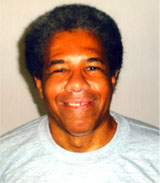







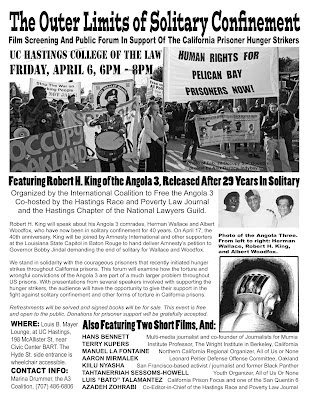



 Bonding With Herman Wallace Inside a Louisiana Dungeon
Bonding With Herman Wallace Inside a Louisiana Dungeon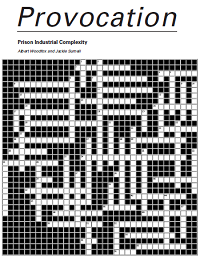 New A3 Crossword Puzzle
New A3 Crossword Puzzle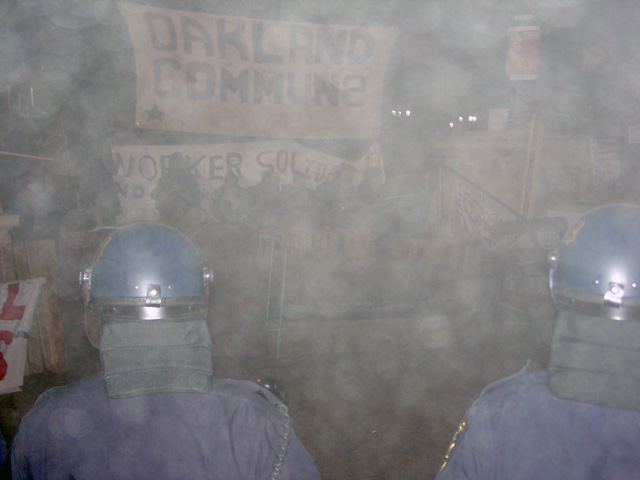
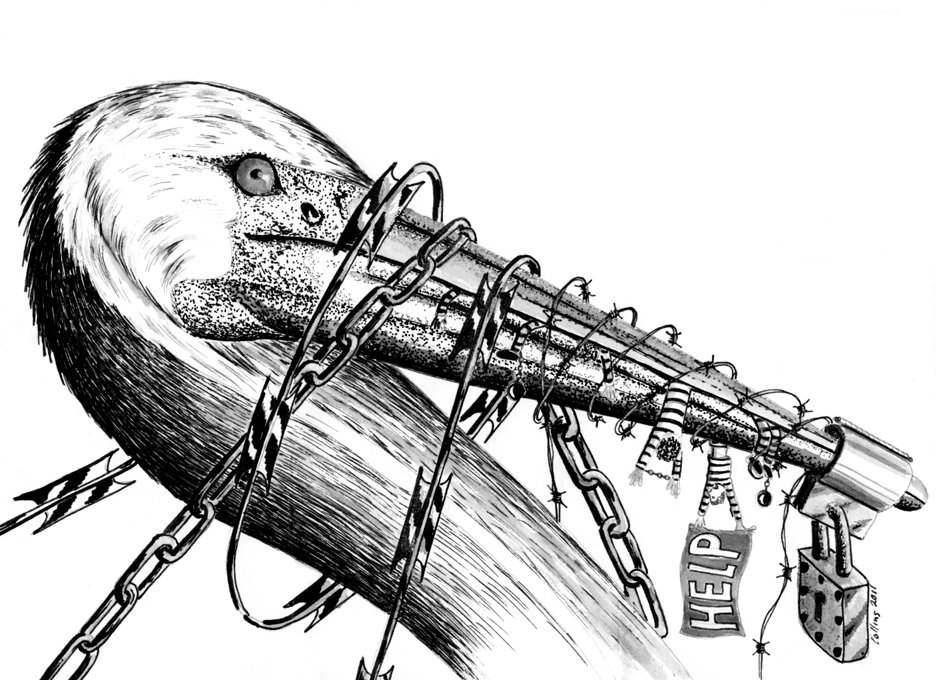

 Will
Will  Anti-Transgender Violence: How Hate-Crime Laws Have Failed
Anti-Transgender Violence: How Hate-Crime Laws Have Failed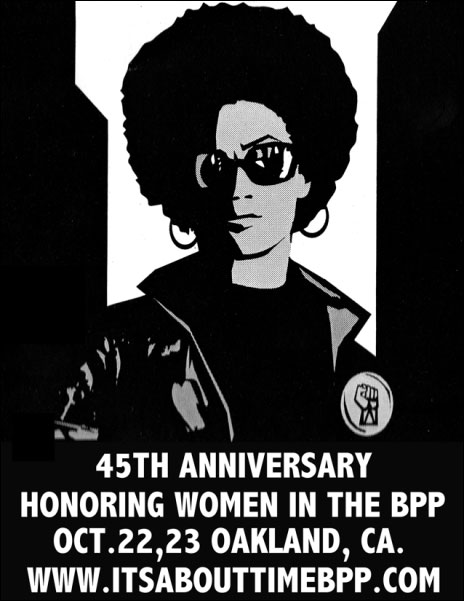 Interviews By Angola 3 News
Interviews By Angola 3 News
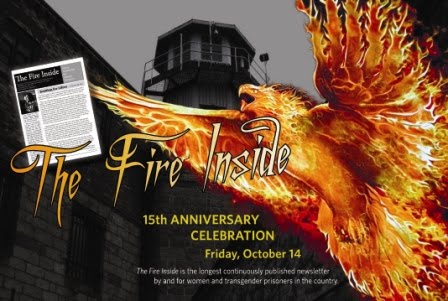 15 Years of Giving Voice to Women and Transgender Prisoners --An interview with the California Coalition for Women Prisoners
15 Years of Giving Voice to Women and Transgender Prisoners --An interview with the California Coalition for Women Prisoners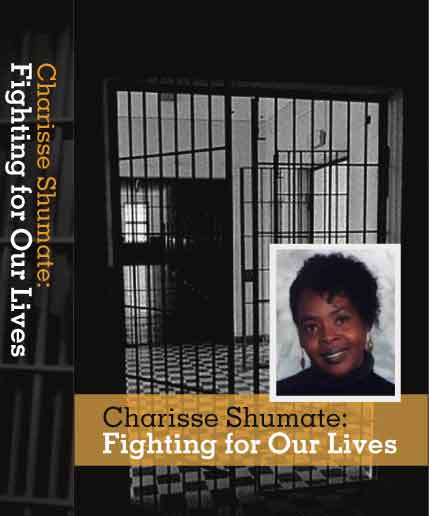
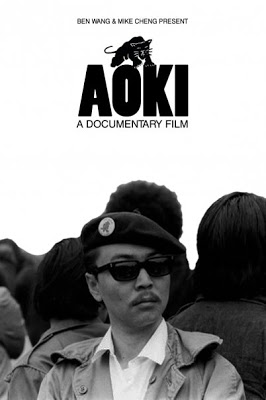 Filming the Inspiring Life of
Filming the Inspiring Life of  Ben Wang previously co-directed the documentary film entitled,
Ben Wang previously co-directed the documentary film entitled, 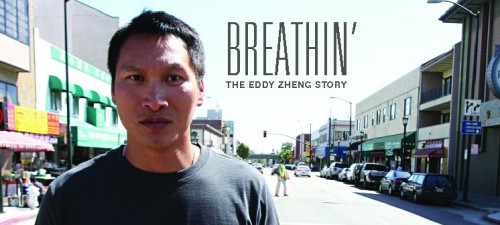
 Troy Davis,
Troy Davis, 




